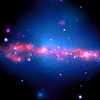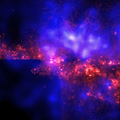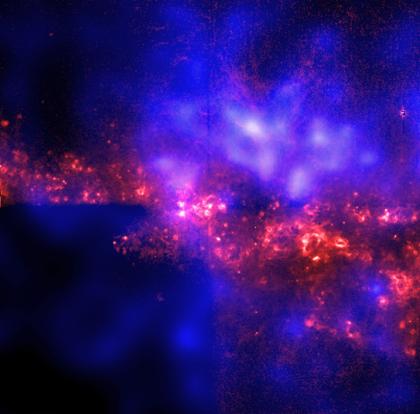Chandra Detects Halo Of Hot Gas Around Milky Way-Like Galaxy
This image shows central region of the spiral galaxy NGC 4631 as seen edge-on from NASA's Chandra X-ray Observatory and Hubble Space Telescope. The Chandra data (shown in blue and purple) provide the first unambiguous evidence for a halo of hot gas surrounding a galaxy that is very similar to our Milky Way. The structure across the middle of the image and the extended faint filaments (shown in orange) represent the observation from Hubble that reveals giant bursting bubbles created by clusters of massive stars. Scientists have debated for over 40 years whether the Milky Way has an extended corona, or halo, of hot gas. Observations of NGC 4631 and similar galaxies provide astronomers with an important tool in the understanding our own galactic environment.
A team of astronomers, led by Daniel Wang of the University of Massachusetts at Amherst, observed NGC 4631 with Chandra's Advanced CCD Imaging Spectrometer (ACIS) instrument. The observation took place on April 15, 2000, and its duration was approximately 60,000 seconds.
|
||||||||||||||||||||||||||
The image is a multiwavelength astronomical image of a spiral galaxy named NGC 4631. This galaxy is located in the constellation Canes Venatici, approximately 25 million light-years away from Earth. The image features red, white and blue colors. The overall structure of the galaxy can be described as a spiral pattern, reminiscent of a pinwheel. This image shows the central region of the spiral galaxy as seen edge-on from NASA's Chandra X-ray Observatory and Hubble Space Telescope. The Chandra data (shown in deep blue, almost purple) provide the first unambiguous evidence for a halo of hot gas surrounding a galaxy that is very similar to our Milky Way. The arm-like structure stretching across the middle of the image and the extended faint filaments (colored in red-orange) represent the observation from Hubble that reveals giant bursting bubbles created by clusters of massive stars. Scientists have debated for over 40 years whether the Milky Way has an extended corona, or halo, of hot gas. Observations of NGC 4631 and similar galaxies provide astronomers with an important tool in understanding our own galactic environment.






